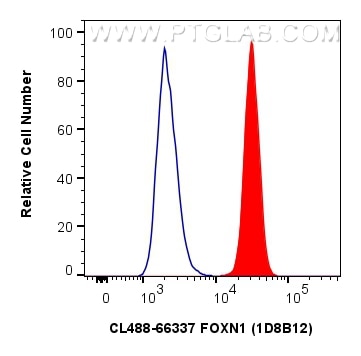Anticorps Monoclonal anti-FOXN1
FOXN1 Monoclonal Antibody for FC (Intra)
Hôte / Isotype
Mouse / IgG1
Réactivité testée
Humain
Applications
FC (Intra)
Conjugaison
CoraLite® Plus 488 Fluorescent Dye
CloneNo.
1D8B12
N° de cat : CL488-66337
Synonymes
Galerie de données de validation
Applications testées
| Résultats positifs en FC (Intra) | cellules A549, |
Dilution recommandée
| Application | Dilution |
|---|---|
| Flow Cytometry (FC) (INTRA) | FC (INTRA) : 0.40 ug per 10^6 cells in a 100 µl suspension |
| It is recommended that this reagent should be titrated in each testing system to obtain optimal results. | |
| Sample-dependent, check data in validation data gallery | |
Informations sur le produit
CL488-66337 cible FOXN1 dans les applications de FC (Intra) et montre une réactivité avec des échantillons Humain
| Réactivité | Humain |
| Hôte / Isotype | Mouse / IgG1 |
| Clonalité | Monoclonal |
| Type | Anticorps |
| Immunogène | FOXN1 Protéine recombinante Ag18207 |
| Nom complet | forkhead box N1 |
| Masse moléculaire calculée | 648 aa, 69 kDa |
| Poids moléculaire observé | 60 kDa |
| Numéro d’acquisition GenBank | BC146539 |
| Symbole du gène | FOXN1 |
| Identification du gène (NCBI) | 8456 |
| Conjugaison | CoraLite® Plus 488 Fluorescent Dye |
| Excitation/Emission maxima wavelengths | 493 nm / 522 nm |
| Forme | Liquide |
| Méthode de purification | Purification par protéine G |
| Tampon de stockage | PBS with 50% glycerol, 0.05% Proclin300, 0.5% BSA |
| Conditions de stockage | Stocker à -20 °C. Éviter toute exposition à la lumière. Stable pendant un an après l'expédition. L'aliquotage n'est pas nécessaire pour le stockage à -20oC Les 20ul contiennent 0,1% de BSA. |
Informations générales
FOXN1, also named as Forkhead box protein N1, is a 648 amino acid protein, which contains 1 fork-head DNA-binding domain and localizes in the nucleus. FOXN1 as transcriptional regulator regulates the development, differentiation, and function of thymic epithelial cells (TECs) both in the prenatal and postnatal thymus. FOXN1 acts as a master regulator of the TECs lineage development and is required from the onset of differentiation in progenitor TECs in the developing fetus to the final differentiation steps through which TECs mature to acquire their full functionality.


